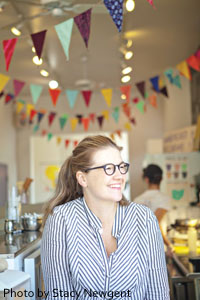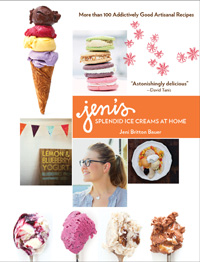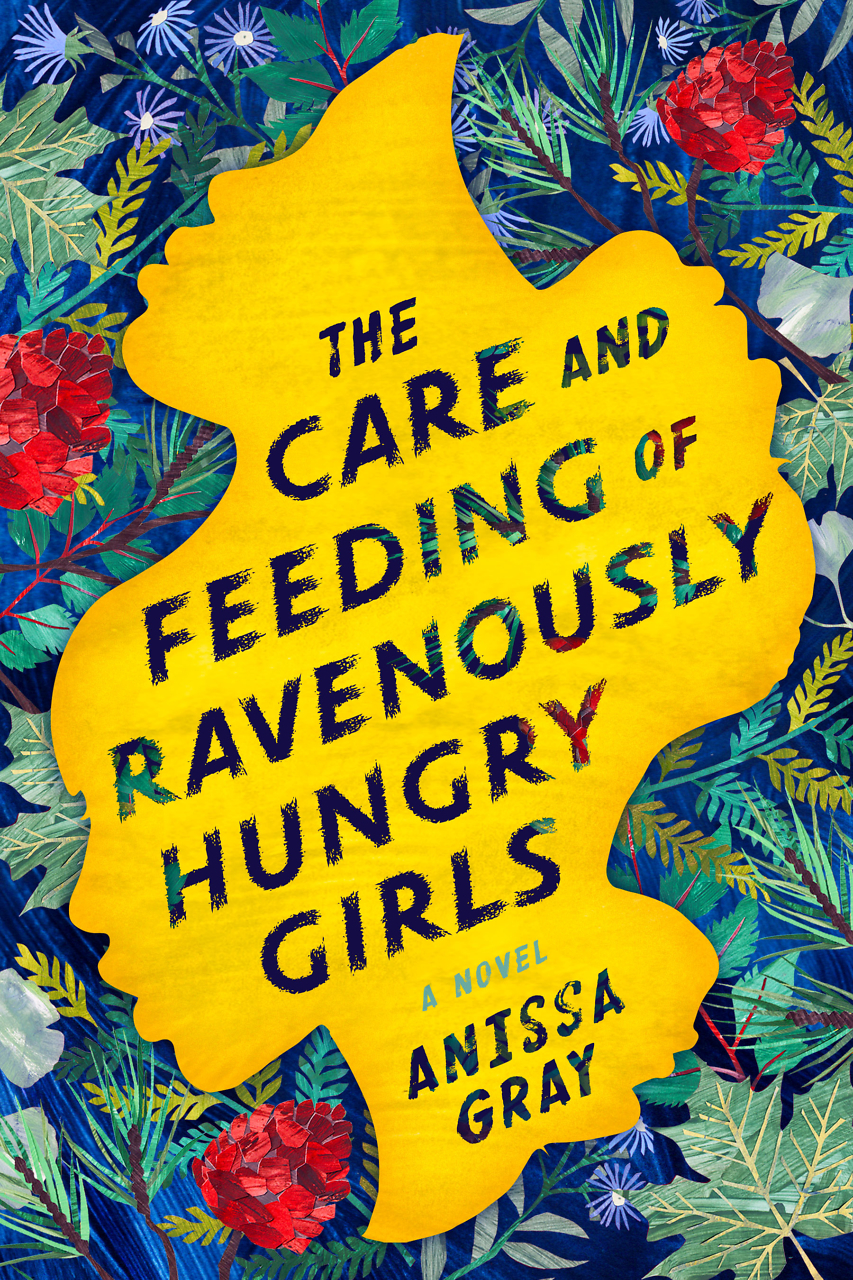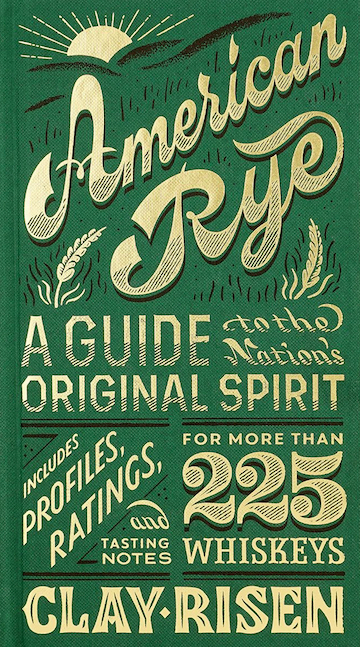Rehabilitating Butterfat
For Jeni Britton Bauer, making splendid ice cream is one way to make the world a better place
First, let us consider butterfat: simply to utter those three low-slung syllables feels a bit deliciously naughty, a mockery of popular scripture about good (as in virtuous) food. If you’re even a part-time worshipper at the altar of health-consciousness, the word butterfat may seem embarrassing in its lusty suggestiveness. Yet there it is, proudly crowning the manifesto of Jeni’s Splendid Ice Cream, a poster of which hangs on the wall of the company’s new East Nashville store, in plain view of customers who queue up daily to taste, spoon, and lick to their heart’s content.
For Jeni Britton Bauer, the creative force behind what is arguably the most celebrated ice cream in the country right now, butterfat is a blank canvas on which to explore a palette of exotic, tantalizing flavors: Salty Caramel, Wildberry Lavender, Cherry Lambic, Bangkok Peanut (cayenne pepper, coconut, honey, and peanut butter ice cream). Still other flavors display an allegiance to place: Jeni’s hails from Columbus, Ohio—hence a flavor called The Buckeye State, a peanut butter and chocolate concoction, and another called Sweet Corn and Black Raspberry, billed as a “taste of Midwestern summer.”
 A family connection fueled the opening, for the first time, of a Jeni’s store outside the state of Ohio: Bauer’s husband’s brother left Nashville to join the company some years back. The ice cream first slipped onto the local scene earlier this year when the latest addition to the Bongo Java set, Hot and Cold, began carrying a limited, rotating selection. But the recent opening of the East Nashville shop comes at an especially buzzy moment for Jeni’s: it coincided with the publication of Bauer’s cookbook, Jeni’s Splendid Ice Creams at Home, which last week made The New York Times bestseller list.
A family connection fueled the opening, for the first time, of a Jeni’s store outside the state of Ohio: Bauer’s husband’s brother left Nashville to join the company some years back. The ice cream first slipped onto the local scene earlier this year when the latest addition to the Bongo Java set, Hot and Cold, began carrying a limited, rotating selection. But the recent opening of the East Nashville shop comes at an especially buzzy moment for Jeni’s: it coincided with the publication of Bauer’s cookbook, Jeni’s Splendid Ice Creams at Home, which last week made The New York Times bestseller list.
The cookbook, which bears the sleek yet homey design aesthetic of the retail shops, features recipes for almost any Jeni’s flavor you can dream of, engineered especially for home equipment. (An observation from two trials: the recipes work. Very well.) There are also how-tos for waffle cones, cocktails featuring said ice creams, and sauces. In an introductory essay, Bauer tells the story of how she went from dishing out interesting ice creams when she was “twenty-two years old and had pink hair and lots of ideas and enthusiasm, but little business acumen,” to operating a wildly successful set of seven stores and, improbably enough, a thriving nationwide home-delivery operation. Her charmingly written personal narrative touches on a lot of timeless entrepreneurial success themes, but it also presents a business firmly in step with current food trends: artisanal production and locally sourced, farm-fresh ingredients. It’s “a true cow-to-cone ice-cream company,” as she puts it.
So what does that mean for Jeni’s outside the Buckeye State? Will a flavor featuring, say, Benton’s bacon join the ranks now that the brand has a Tennessee outpost? We can hope. But on the opening night of the new store—as a line of free-ice-cream seekers stretched hundreds of feet through the parking lot in the humid dusk—Bauer greeted her newest customers and said she didn’t plan to send empty trucks back to Ohio: she’d been scouting farms, and Tennessee fruit would certainly make a showing in her ice creams.
Chapter 16 spoke to Bauer by phone, while she was in New York on book tour, which includes a Nashville stop on July 21.
Chapter 16: You got your start in the food business by working in a French bakery. How did ice cream seize your interest; why has that passion endured?
Bauer: I grew up with a grandmother who was an artist and very tactile. We spent a lot of time in the woods, and I think it was there that I was opened to the sensory experience, which I immediately connected with art. We had all kinds of projects out there. We built a teepee one summer; we built a cabin; we had a creek we would swim in and catch things in. There was always something going on in the woods. It didn’t matter if it was freezing out or super hot, we were still there.
For me, ice cream is another full and rich sensory experience. As soon as I realized it could be cold and creamy and then hot, it was like music to me, or a painting. So when I really started perusing the market, looking at flavors, I immediately thought, “Forget about chocolate chip and cookie dough, they’re already done! Let’s do basil and rose petal…and let’s meet people, and make flavors that represent what they do.” It’s a way to tell stories, the same way you do when you create a song or painting, and I was used to that.
Chapter 16: You were also trained as an artist before you started making ice cream, right?
Bauer: I was trying to get trained as an artist. I was going to art school and taking art history classes. And I grew up doing art with my grandmother every weekend.
Chapter 16: It seems to me that ice cream is more decadent, perhaps, than many other sweets. What do you think it is about ice cream that sets it apart?
Bauer: I’m a huge dessert freak; I love them all. But butterfat—the fat that’s in cream—melts perfectly at body temperature. Other fats don’t do that. Butterfat absorbs flavor: when you put butter next to an onion, it’ll start to taste like an onion. So you can flavor butterfat with all these wonderful things, and then freeze it so the flavor is locked in there, and then it gets released through the warmth of your tongue. Just talking about ice cream like this is extremely emotional, sexy. I feel like that’s just so much more wonderful, even though I love cupcakes, than eating a cupcake. And sharing ice cream is one of the best things, too. Everybody gets their own flavor and has a taste of everyone else’s flavor. If you’re dating someone you might give them a lick off your cone. It’s just such a shareable experience.
Chapter 16: It also has that ageless quality. It’s something children and adults can effortlessly share.
Bauer: Which is what sensuality is, you know? When you’re a kid and you’re just so filled with energy and enthusiasm for life, and you’re seeing things [for the first time], everything is a rich sensory experience. You’re more open to things.
Chapter 16: Speaking of kids, you ate several One Night in Bangkok sundaes a week when you were pregnant with your daughter and son. I read that and thought, Oh my. I really need to be pregnant again.
Bauer: I’m telling you, it’s just the biggest excuse to go for it. I love that sundae so much.
Chapter 16: It sounds like you started out with this right-brain sensibility—you were into nature and art as a kid—but in building Jeni’s you seem to have become an excellent businesswoman. Have you changed, and has the company grown as a result?
Bauer: I’m right between right- and left-brained. All the tests when I was growing up put me right in the middle, and I think that actually makes me more creative. It’s served me well in business, because I love creating flavors and the environments, and doing the artwork—being the creative director for the company, basically. But I also like making real things happen. And I think entrepreneurism is the fastest way to make social change. When you can build up a company, build money, and then spend it with the people you love and care about—knowing the people you buy things from—that is one of the best things you can do for America.
But my husband and brother-in-law have also been instrumental. My husband is very statistical, and without his close watch on the finances, we wouldn’t be what we’ve become. And Tom, my brother-in-law, he’s a go-getter. He’s built our online business; without him we wouldn’t have that. And more recently, last year, we added our really good friend John Lowe [as CEO], and I stepped away from [that role]. This is one of the smartest things we’ve ever done as a company. We have been very smart in terms of building our company so that we can be solid and safe. It’s difficult to raise a company; it’s a lot like raising a kid. It sort of takes on its own personality [based on] all the people that are a part of it. So making sure you have the right people to help is hugely important.
 Chapter 16: In the section of your new book called “Jeni’s Story,” you’re pretty frank about some of the hiccups the company experienced along the way. What’s the main advice you’d offer a young artisan who’s just starting out and has big visions for the future?
Chapter 16: In the section of your new book called “Jeni’s Story,” you’re pretty frank about some of the hiccups the company experienced along the way. What’s the main advice you’d offer a young artisan who’s just starting out and has big visions for the future?
Bauer: The best thing you can do is to start and operate your company on a shoestring. Start at home, or start at a market, like I did. City markets are a great incubator for a business, and every city should have one. Run your business on a shoestring: put all your money back in. And understand that you’re going to make mistakes, but that’s OK; keep moving. Just know that it’s going to take a long time. I’ve been at it for fifteen years, most of which I was living paycheck to paycheck and driving a beat-up old red truck. You have to go all in on it, but the reward is so great, and even while you’re in it, it’s such a wonderful thing to do. You meet so many people, and it’s just a beautiful life. You have to work a lot. Never think that you’re going to spend more time with your family if you start a business, because you’re definitely going to spend less. You have to be very structured. Build your market very slowly, and really do try to make something that’s different, and unique, or find a twist on it.
Chapter 16: You write, “In every way, our business is based on a new creative model, and none of the old rules apply.” How do you see Jeni’s as breaking the old rules of ice cream business?
Bauer: In general, in a traditional ice-cream company, you would buy an ice-cream mix from a big dairy and flavor it with something. And that’s your ice cream. I was disappointed with that. It seemed like buying a cake mix and saying it’s homemade. It wasn’t special enough. We want to make our own stuff from the ground up, like a microbrewery does.
In terms of bigger-picture business, traditionally, you want to have twenty percent growth, twenty percent more profit annually. Our business is nothing like that. We want to work directly with people we know. Our profit margins aren’t anywhere near what a Wall Street business would accept, but we’re all very happy, we support a lot of people, and we have this great community. The tide is rising for us all.
Chapter 16: As for the cookbook, how does it, too, do things differently?
Bauer: If you look at all the other ice-cream books on the market, they all start with basically the same recipe, which is a custard recipe, or occasionally you’ll find a Philadelphia-style ice cream, which I don’t like; it’s kind of icy. Even the custard style is icy on a home machine. Even the top chefs’ books have that same basic recipe that they learned in cooking school, and it really doesn’t work at home very well. So instead of starting with the recipe that everyone uses, I started with the texture that I wanted to achieve. I wanted it to be smooth and creamy and scoopable. I tried to start backwards from what I wanted to achieve, and create a recipe around that.
Chapter 16: And that meant no eggs, which are found in custard-style ice cream.
Bauer: We don’t use eggs in our kitchen. I wasn’t going to put a book out that didn’t actually match what I create in my kitchen. I wanted to make sure that you could get that same texture. Often, when companies [or restaurants] put out cookbooks, their ice cream that you can make at home is very different from what they sell in the store. And that disappointed me. If I’m using Thomas Keller’s book, I want to be able to make it as close to what I actually get in his restaurant as possible.
Chapter 16: You write that you attended the “famous Ice Cream Short Course at Penn State.” What was that like?
Bauer: They don’t talk about anything delicious. It’s all fat globules and molecules and sucrose and glucose. So I learned about how all these things work together and how every ingredient is very important in the final product, and it all has to be perfectly in balance. Otherwise, it doesn’t work. And that solidified all the stuff that I’d sort of been learning already. I had already made ice cream for three and a half years, so I had all this intuitive knowledge I had built. If I’d gone there before I started playing around with ice cream, trial and error, it probably wouldn’t have made sense to me. It’s really designed for people who work at dairy plants. For a small-time artisan, it’s not that helpful unless you’ve been doing it for a while.
Chapter 16: Your cookbook includes short narratives about your suppliers, like Warren Taylor of Snowville Creamery and Shawn Askinosie of Askinosie Chocolate. Why did you want those to be part of the book?
Bauer: I wanted to tell my stories, the way that I’ve experienced it. Whenever I read someone else’s book, I apply it to my own life. So I thought, “If I’m honest and open and put everything out there that I’ve experienced, someone who reads it might go find their dairy guy,” or find the person growing the apples nearby. We all have these communities. And I thought that bringing mine to the forefront might help you (the reader) see your community as full of flavor, and then you might go and find your strawberry grower, or whatever, and make your ice cream out of that.
Chapter 16: Is there any story behind the choice of the word “splendid” in the company’s title?
Bauer: I love the word; I feel like it’s just delicious, you know? It is definitely about a sensory experience. But I also feel like it gives us a lot of creative freedom. We can say the word artisanal and I do think it applies to us, but not always. It gives us the room to make whatever ice creams we want to. To follow whatever curiosity we want, instead of having to be all all-natural, or all old-fashioned, or artisanal. We can be all those things whenever we want to.
Chapter 16: Do you ever tire of ice cream?
Bauer: I’ve never become tired of ice cream, and I’m not just saying that. I love eating sundaes. I have to stop myself because I would eat a sundae every day. I have to save it for special occasions. And I also love trying other people’s ice creams. I was just in San Francisco, and I had this really great ice cream at a restaurant called Zero Zero. I always order ice cream if it’s on the menu.
Chapter 16: Who are your ice cream inspirations?
Bauer: I have so much love for Ben & Jerry, particularly Ben Cohen, for everything that he did to make ice cream delicious and responsible. What they did was exceptional. We feel like we’re carrying the torch a little bit. We have to involve our communities and be good.
Chapter 16: You chose Nashville for your first store outside of Ohio in part because of your brother-in-law’s connection to the city. But why East Nashville specifically? Green Hills and Franklin so often, um, scoop up the big-name businesses from out of town.
Bauer: There’s no doubt that East Nashville fits our personality better than anywhere else. We like emerging, artistic, bohemian neighborhoods; that’s where we feel most at home. In Columbus, we have the Short North, and that’s where we feel the most freedom to do what we want to do. For us, and for my personality, East Nashville gives us the freedom to be as creative as we want to be, and that was the number-one most important thing for us.
Chapter 16: There’s no denying that Jeni’s is on the pricey end, as ice cream goes. Pints are twelve bucks a pop. Some people feel that’s outrageous. What’s your response?
Bauer: Food is expensive—and we use beautifully made grass-fed milk and cream. That’s our biggest expense. On top of that, we’re trying our best to use single-origin, single-farm chocolates. I think in the end that it all pays off. Your extra dollar, or extra bucks, that you spend on our ice cream—I hope it gives you so much more. I know a lot of our customers find that once they have our ice cream, they don’t go back. Our ice cream is high in butterfat with very little air. So, like a chocolate truffle or cheesecake, you don’t need much of it. You may not think about it until the next time you have another ice cream, something that’s full of air, and you’ll think, “Hm, I paid three dollars for this, and it’s nothing like what Jeni’s is making.” You’re getting a lot more in terms of the whole experience. When you come to our store, you’re encouraged to try as many flavors as you want; you’re never rushed through the line. It’s a date. But most ice cream is yummy in some way or another. We’re just adding to the world of ice cream.
Jeni Britton Bauer will sign and demonstrate recipes from Jeni’s Splendid Ice Creams At Home at Williams-Sonoma in the Mall at Green Hills in Nashville on July 21 at 3 p.m.





